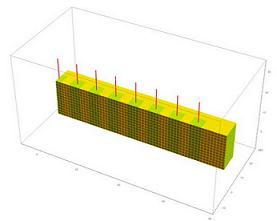
Combining photo-responsive fibers with thermo-responsive gels, researchers at the University of Pittsburgh’s Swanson School of Engineering and Clemson University have modeled a new hybrid material that could reconfigure itself multiple times into different shapes when exposed to light and heat, allowing for the creation of devices that not only adapt to their environment, but also display distinctly different behavior in the presence of different stimuli.
Computational modeling developed by McGowan Institute for Regenerative Medicine affiliated faculty member Anna Balazs, PhD, Distinguished Professor of Chemical and Petroleum Engineering at Pitt, and Olga Kuksenok, PhD, Associate Professor of Materials Science and Engineering at Clemson’s College of Engineering and Science, predicted these composites would be both highly reconfigurable and mechanically strong, signaling a potential for biomimetic four-dimensional printing. Their research, “Stimuli-responsive behavior of composites integrating thermo-responsive gels with photoresponsive fibers,” was recently published in the journal Materials Horizons, published by the Royal Society of Chemistry.
“In 4D printing, time is the fourth dimension that characterizes the structure of the material; namely, these materials can change shape even after they have been printed. The ability of a material to morph into a new shape alleviates the need to build a new part for every new application, and hence, can lead to significant cost savings,” Dr. Balazs explained. “The challenge that researchers have faced is creating a material that is both strong and malleable and displays different behavior when exposed to more than one stimulus.”
Drs. Balazs and Kuksenok resolved this issue by embedding light-responsive fibers, which are coated with spirobenzopyran (SP) chromophores, into a temperature-sensitive gel. This new material displays distinctly different behavior in the presence of light and heat.
“If we anchor a sample of the composite to a surface, it will bend in one direction when exposed to light, and in the other direction when exposed to heat,” Dr. Kuksenok said. “When the sample is detached, it shrinks like an accordion when heated and curls like a caterpillar when illuminated. This programmable behavior allows a single object to display different shapes and hence functions, depending on how it is exposed to light or heat.”
The researchers note that by localizing the SP functionality specifically on the fibers, the composites can encompass “hidden” patterns that are only uncovered in the presence of light, allowing the material to be tailored in ways that would not be possible by simply heating the sample. This biomimetic, stimuli-responsive motion could allow for joints that bend and unbend with light and become an essential component for new adaptive devices, such as flexible robots.
“Robots are wonderful tools, but when you need something to examine a delicate structure, such as inside the human body, you want a “squishy” robot rather than the typical devices we think of with interlocking gears and sharp edges,” Dr. Balazs said. “This composite material could pave the way for soft, reconfigurable devices that display programmed functions when exposed to different environmental cues.”
As Dr. Balazs points out, “the real significance of the work is that we designed a single composite that yields access to a range of dynamic responses and structures. On a conceptual level, our results provide guidelines for combining different types of stimuli-responsive components to create adaptive materials that can be controllably and repeatedly actuated to display new dynamic behavior and large-scale motion.”
Future research with this discovery will focus on tailoring the arrangements of the partially-embedded fibers to create hand-like structures that could serve as a type of gripper.
Illustration: University of Pittsburgh Swanson School of Engineering.
Read more…
University of Pittsburgh Swanson School of Engineering News Release
Engineering and Technology Magazine
Product Design and Development Net
American Gear Manufacturers Association
Elsevier Material Science News
Abstract (Stimuli-responsive behavior of composites integrating thermo-responsive gels with photo-responsive fibers. Olga Kuksenok and Anna C. Balazs. Materials Horizons; online November 9, 2015.)
